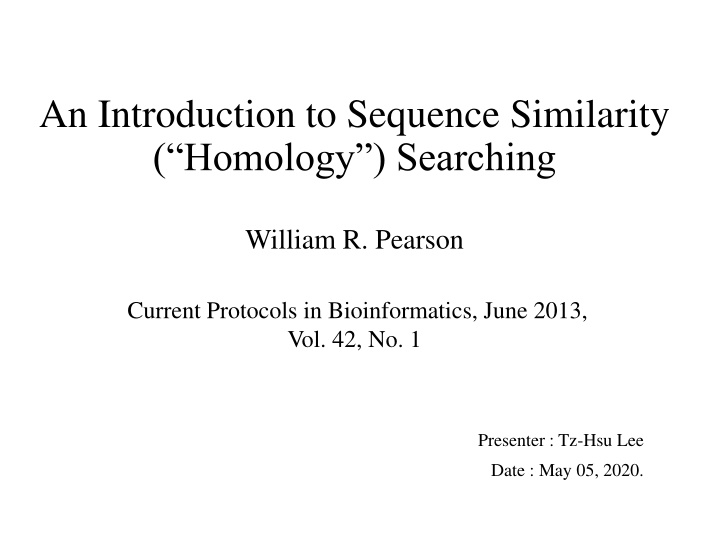
Introduction to Sequence Similarity Searching
Explore sequence similarity searching and homology in bioinformatics, including the inference of homology from significant similarity and the use of BLAST and other tools for identifying homologs.
Download Presentation

Please find below an Image/Link to download the presentation.
The content on the website is provided AS IS for your information and personal use only. It may not be sold, licensed, or shared on other websites without obtaining consent from the author. If you encounter any issues during the download, it is possible that the publisher has removed the file from their server.
You are allowed to download the files provided on this website for personal or commercial use, subject to the condition that they are used lawfully. All files are the property of their respective owners.
The content on the website is provided AS IS for your information and personal use only. It may not be sold, licensed, or shared on other websites without obtaining consent from the author.
E N D
Presentation Transcript
An Introduction to Sequence Similarity ( Homology ) Searching William R. Pearson Current Protocols in Bioinformatics, June 2013, Vol. 42, No. 1 Presenter: Tz-Hsu Lee Date : May 05, 2020.
Abstract Sequence similarity searching, typically with BLAST, is the most widely used, and most reliable, strategy for characterizing newly determined sequences. Sequence similarity searches can identify homologous proteins or genes by detecting excess similarity statistically significant similarity that reflects common ancestry. This unit provides an overview of the inference of homology from significant similarity, and introduces other units in this chapter that provide more details on effective strategies for identifying homologs.
Homology Similarity due to shared ancestry between a pair of structures or genes in different taxa. ex:
Homologous sequences Form the basis for more sensitive searches Phenotype prediction Evolutionary analysis
Sequence similarity searching Sequences that share significant similarity can be inferred to be homologous; they share a common ancestor. BLAST PSI-BLAST SSEARCH FASTA and the HMMER3 Is there a related sequence with a similar function?
Homology from similarity(1/2) Excess similarity implies common ancestry Translated-DNA : protein Bit scores E-values
E-values K ? : constant m : the length of query sequence n : the lengths of the sequences in the database S : raw score
Bit score K ? : constant S : raw score
Function from homology Orthology Paralogy
Conclusion Similarity searching programs produce accurate statistical estimates that can be used to reliably infer homology. Searches with protein or translated DNA sequences are preferred E()-values and bit scores (bits > 50) are far more sensitive and reliable than percent identity for inferring homology.
